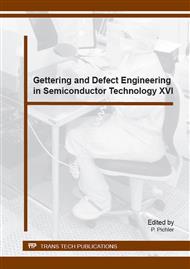[1]
M.G. Mil'vidskii, V.V. Chaldyshev, Nanoscale atomic clusters in semiconductors as a new approach to formation of material properties, Fiz. Tekhnika Poluprov. 32 (1998) 513.
Google Scholar
[2]
S. Eichler, J. Gebauer, F. Börner, A. Polity, R. Krause-Rehberg, E. Wendler, B. Weber, W. Wesch, H. Börner, Defects in silicon after B+implantation: A study using a positron-beam techniques, Rutherford backscattering, secondary neutral mass-spectroscopy. Phys. Rev. B 56 (1997).
DOI: 10.1103/physrevb.56.1393
Google Scholar
[3]
A. Usami, M. Katayama, J. Tokuda, T. Wada, Diode characteristics and residual deep-level defects of p+–n abrupt junctions fabricated by rapid thermal annealing of boron implanted silicon, Semicond. Sci. Technol. 2 (1987) 83.
DOI: 10.1088/0268-1242/2/2/003
Google Scholar
[4]
N.A. Sobolev, A.M. Emelianov, E.I. Shek, V.I. Vdovin, Influence of post-implantation annealing on the properties of silicon light-emitting diodes obtained by boron implantation in n-Si, Physika Tverd. Tela 46 (2004) 39.
DOI: 10.1134/1.1641916
Google Scholar
[5]
A.R. Cheladinski, Ph. Ph. Komarov, Defect-impurity engineering in implanted silicon. Uspekhi Fizicheskikh Nauk, 173, (2003) 813.
DOI: 10.3367/ufnr.0173.200308b.0813
Google Scholar
[6]
S.L. Libertino, A. La Magna, Damage formation and evolution in ion-implanted crystalline Si, in H. Bernas (Ed. ), Materials Science with ion beams, Springer, Heidelberg, 2010, pp.147-204.
DOI: 10.1007/978-3-540-88789-8_6
Google Scholar
[7]
Wai Lek Ng., M.A. Lourenço, R.M. Gwilliam, S. Ledain, G. Shao, K.P. Homewood, An efficient room-temperature silicon-based light-emitting diode, J. Nature, 410 (2001) 1036.
DOI: 10.1038/35065571
Google Scholar
[8]
N.P. Khuchua, N.D. Dolidze, N.G. Gapishvili, R.G. Gulyaev, Z.V. Jibuti, R.G. Melkadze, M.G. Tigishvili, Technology of semiconductor materials sensitive to different regions of the electromagnetic radiation spectrum, Nanotechnology Perceptions 10 (2014).
DOI: 10.4024/n09kh14a.ntp.010.02
Google Scholar
[9]
M.G. Tigishvili, N.P. Khuchua, R.G. Melkadze, N.D. Dolidze, N.G. Gapishvili, Z.V. Jibuti, G. Dovbeshko, V. Romanyuk, Semiconductor material with new optical properties for infrared and ultraviolet photodetectors, 2nd International Conference Modern Technologies and Methods of Inorganic Materials Science, 20-24 April (2015).
DOI: 10.4028/www.scientific.net/ssp.242.374
Google Scholar
[10]
A.N. Mikhailov, A.I. Belov, D.S. Korolev, A.O. Timofeeva, V.K. Vasilyev, A.N. Shushunov, A.I. Bobrov, D.A. Pavlov, D.I. Tetel'baum, E.I. Shek, Influence of ion doping on photoluminescence in Si associated with dislocations formed by Di ion implantation, Fiz. Tekhnika Poluprov. 48 (2014).
DOI: 10.1134/s1063782614020183
Google Scholar
[11]
M. Razerghi, A. Rogalski, Semiconductor ultraviolet detectors, Applied Physics Reviews 10 (1996) 7434-7470.
Google Scholar


